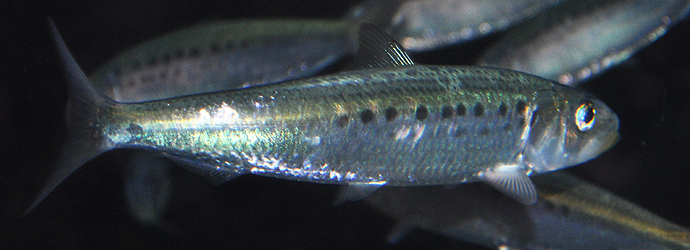 |
| Pacific Herring Clupea pullasi source |
Some species of fish, including the Pacific
herring, have developed an even more advanced method of hearing. Herring have three pairs of organs called
Weberian ossicles which directly connect the swim bladder to the inner
ear. This structure forms two vesicles
close to the otolith with one vesicle sending sensations directly into the
utricle, which acts as a functional ear.
These sensations are then converted into vibrations which are interpreted
by the fish (Enger 1967). This advanced
system allows herring to hear very well and increases survivability. So, how would having excellent hearing
directly benefit Pacific herring?
What
a fish hears directly affects how a fish responds. Herring, which are a schooling fish, use
their increased sound reception to precisely locate a sound and then decide whether
to adjust its movement speed, seek out other individuals to increase school
size, or change direction. Since sound
travels much faster underwater and comes from all directions the fish must be
able to detect exactly where a sound originates. Pacific herring use their excellent hearing
to precisely determine a sound’s source allowing them to determine if there is
danger. Since fish are almost constantly
picking up various sounds they must have a way to filter out the important
sounds. Sounds must increase generally by
20-30 dB before any response is seen, in effect cancelling out surrounding
“white” noise (Schwarz and Greer, 1984).
This ability to determine sound volume allows them to adjust to constant
sounds even at higher decibels. Once the
initial startle response has occurred if the herring sense no danger, but the
sound persists, they will continue to ignore it.
 |
| Audiograms depict faintest sounds of differing frequencies detected by different fish. source |
Herring
response to sound has generally been categorized as a startle or avoidance
response. Short or low frequency sound will
cause a brief directional response (a startle) while high or continuing sound will
cause schooling, sinking in the water column, or fleeing the area (avoidance
response). Herring response to
differences in sound pitch aid survival by helping the fish avoid predators,
particularly whales. Wilson and Dill
(2002) experimented with how sounds affect herring shoals and showed feeding
fish would cease feeding and begin to school when threatened and that already schooling
fish would increase speed while dropping in the water column. This ability to hear amazingly well allow
herring to adjust their behavior in response to potential predation thereby
increasing survivability.
It
is easy to look at a fish and believe they have poor hearing, or lack hearing
all together. They have no ears or other
openings that make sound recognition apparent.
All fish can hear the only variation is how hearing occurs. Different species have developed functional
hearing that is appropriate to their survival and surroundings. Herring have developed advanced hearing that
allows them to filter through an abundance of sound, know where the sound is
coming from and respond. They react to
their surroundings, avoid predators and change directions in a school without
colliding into one another. They are
able to detect subtle changes in pressure and ionic disturbance as well as
adjust to a constant non-threatening sounds.
Pretty remarkable for an animal that typically only reaches a foot in
length and has a relatively small brain.
So remember the next time you are at an aquarium and the sign says
“Please don’t tap on the glass” that it’s because the fish can hear that
tapping. In fact some of them hear it
very, very well.
References
Enger,
S. 1967. Hearing in Herring. Comparative
Biochemistry and Physiology 22:527-538.
Higgs,
D. M., and C. A. Radford. 2013. The contribution of the lateral line to
‘hearing’ in Fish. Journal of
Experimental Biology 216:1484-490.
Schwarz, A.L., and G.L. Greer. 1984. Responses of Pacific herring,
Clupea harengus pallasi, to some underwater
sounds. Canadian Journal of Fish and Aquatic Sciences 41:1183-1192.
Wilson, Ben, and
Lawrence M. Dill. 2002. Pacific Herring respond to simulated Odontocete echolocation sounds. Canadian Journal
of Fisheries and Aquatic Sciences 59.3:542-53.





A town hall meeting is where Mr. Enzi will encounter folks the Senator doesn’t hear from in the normal course of his meanderings. A town hall meeting is where the Senator will see the faces and hear the voices of those who are afraid or angry and he’ll feel their raw, unrehearsed emotion in a way that can never be conveyed by an email or a phone call answered by a member of his staff.
ReplyDeleteclick here